Fusion of Improved Sparrow Search Algorithm and Long Short-Term Memory Neural Network Application in Load Forecasting
Abstract
:1. Introduction
2. How Power Load Forecasting Works
3. Short-Term Load Forecasting Is Described Using the ILSTM-NN
4. Recurrent Neural Network (RNN)
5. Long Short-Term Memory Neural Network
6. Optimization of Load Forecasting Model with Improved Sparrow Search Algorithm (ISSA, Also Named Chaos Sparrow Search Algorithm, CSSA)
6.1. Optimization of LSTM-NN Parameters
6.2. CSSA Optimizes LSTM-NN
6.2.1. Model Design
6.2.2. The Basic Principles of the CSSA
6.2.3. CSSA Designs the Appropriate Rules
- Discoverers usually have high energy reserves. They are responsible for searching for food-rich areas throughout the species, providing foraging areas and directions for all adders, and in modeling, the level of energy reserves depends on the individual sparrow and the corresponding adaptability values.
- Once the sparrow finds the predator, the individual sends out an alarm signal, and when the alarm value is greater than the safe value, the finder takes the adders to another safe area foraging.
- The identity of the discoverer and the adders is dynamic, and each sparrow can be the discoverer as long as a better food source can be found. However, the proportion of the discoverers and the adders in the entire population is constant. When one sparrow becomes a discoverer, another sparrow becomes the adder.
- The lower the adders' energy, the worse their foraging position throughout the species, and some hungry adders are more likely to fly elsewhere for food and more energy.
- During foraging, adders can always search for the finder that provides the best food, or forage around the finder, while some adders may constantly monitor the finder to compete for food resources to increase their predation rate.
- When aware of the danger and what will happen, the sparrow at the edge of the family moves quickly towards a safe area to find a better position. The sparrow in the middle of the family will only move randomly, close to the other sparrows.
6.3. The Design and Steps of the CSSA
6.3.1. The Initial Group Is Generated
6.3.2. Design Adaptation Functions
6.3.3. Sparrow Search Acting Algorithm
6.3.4. CSSA’s Training Process for LSTM-NN
7. Use ILSTM-NN for Short-Term Load Forecasting Models
8. Simulation and Results Using Load Forecasting for a Region as an Example
8.1. Load Forecasting for Different Dates
8.2. Load Forecasting of Different Methods of Different Dates then Obtaining MAPE and Max MAPE
- ANN: Artificial Neural Network method.
- EP-ANN: With ANN as the main body of the forecasting model, and uses Evolutionary Programming (EP) to train its parameters.
- GA-LSTM: With LSTM as the main body of the forecasting model, and uses Genetic Algorithm (GA) to train its parameters.
- PSO-LSTM: With LSTM as the main body of the forecasting model, and uses Particle Swarm Optimization (PSO) to train its parameters.
- ILSTM-NN: The method used in this paper.
9. Conclusions
Funding
Data Availability Statement
Conflicts of Interest
References
- Haida, T.; Muto, S. Regression-based peak load forecasting using a transformation technique. IEEE Trans. Power Syst. 1994, 9, 1788–1794. [Google Scholar] [CrossRef]
- Chen, J.; Wang, W.; Huang, C. Analysis of an adaptive time-series autoregressive moving-average (ARMA) model for short-term load forecasting. Elect. Power Syst. Res. 1995, 34, 187–196. [Google Scholar] [CrossRef]
- Charytoniuk, W.; Chen, M.S.; Van Olinda, P. Nonparametric regression-based Short-term load forecasting. IEEE Trans. Power Syst. 1998, 13, 725–730. [Google Scholar] [CrossRef]
- Amjady, N. Short-Term hourly load forecasting using time-series modeling with peak load estimation capability. IEEE Trans. Power Syst. 2001, 11, 498–505. [Google Scholar] [CrossRef]
- AI-Hamadi, H.M.; Soliman, S.A. Short-Term electric load forecasting based on Kalman filtering algorithm with moving window weather and load model. Electr. Power Syst. Res. 2004, 68, 47–59. [Google Scholar] [CrossRef]
- Mastorocostas, P.A.; Theochairs, J.B.; Bakirtzis, A.G. Fuzzy modeling for short-term load forecasting using the orthogonal least squares method. IEEE Trans. Power Syst. 1999, 14, 29–36. [Google Scholar] [CrossRef]
- Sholahudin, S.; Han, H. Simplified dynamic neural networks model to predict heating load of the building using Taguchi method. Energy 2016, 115, 1919–1926. [Google Scholar] [CrossRef]
- Liao, G.C. Hybrid Improved Differential Evolution and Wavelet Neural Networks with Load Forecasting Problem of Air Conditioning. Int. J. Electr. Power Energy Syst. 2014, 61, 673–682. [Google Scholar] [CrossRef]
- Niu, D.; Wang, Y.; Wu, D.D. Power Load Forecasting Using Support Vector Machine and Ant Colony Optimization. Expert Syst. Appl. 2010, 37, 2531–2539. [Google Scholar] [CrossRef]
- Yang, A.; Li, W.; Yang, X. Short-Term electricity load forecasting based on feature selection and Least Squares Support Vector Machines. Konwl. -Based Syst. 2019, 163, 159–173. [Google Scholar] [CrossRef]
- Xuan, Y.; Si, W.; Zhu, J.; Sun, Z.; Zhao, J.; Xu, M.; Xu, S. Multi-Model Fusion Short-Term Load Forecasting Based on Random Forest Feature Selection and Hybrid Neural Network. IEEE Access 2021, 9, 69002–69009. [Google Scholar] [CrossRef]
- Long, Y.; Su, Z.; Wang, Y. Monthly load forecasting model based on seasonal adjustment and BP neural network. Syst. Eng. Theory Pract. 2018, 38, 1052–1060. [Google Scholar]
- Feng, T.; Zhang, J. Assessment of aggregation strategies for machine-learning-based short-term load forecasting. Electr. Power Syst. Res. 2020, 184, 106304. [Google Scholar] [CrossRef]
- Khwaja, A.S.; Anpalagan, A.; Naeem, M.; Venkatesh, B. Joint bagged-boosted artificial neural networks: Using ensemble machine learning to improve short-Term electricity load forecasting. Electr. Power Syst. Res. 2020, 13, 1630–1637. [Google Scholar] [CrossRef]
- Mehedi, I.M.; Bassi, H.; Rawa, M.J.; Ajour, M.; Abusorrah, A.; Vellingiri, M.T.; Salam, Z.; Abdullah, P.B. Intelligent Machine Learning with Evolutionary Algorithm based Short Term Load Forecasting in Power System. IEEE Access 2021, 9, 100113–100124. [Google Scholar] [CrossRef]
- Hossen, T.; Plathottam, S.J.; Angamuthu, R.K.; Ranganathan, P.; Salehfar, H. Short-term load forecasting using deep neural networks (DNN). In Proceedings of the North American Power Symposium (NAPS), Morgantown, WV, USA, 17–19 September 2017; pp. 1–6. [Google Scholar]
- Ryu, S.; Noh, J.; Kim, H. Deep neural network-based demand side short term load forecasting. Energies 2017, 10, 3. [Google Scholar] [CrossRef]
- Zang, H.; Cheng, L.; Ding, T.; Cheung, K.W.; Liang, Z.; Wei, Z.; Sun, G. Hybrid method for short-Term photovoltaic power forecasting based on deep convolutional neural network. IET Gener. Transm. Distrib. 2018, 12, 4557–4567. [Google Scholar] [CrossRef]
- Rafi, S.H.; Masood, N.A.; Deeba, S.R.; Hossain, E. A Short-Term Load Forecasting Method Using Integrated CNN and LSTM and Network. IEEE Access 2021, 9, 32436–32448. [Google Scholar] [CrossRef]
- Deng, Z.; Wang, B.; Xu, Y.; Xu, T.; Liu, C.; Zhu, Z. Multi-scale convolutional neural network with time-cognition for multi-step short-term load forecasting. IEEE Access 2019, 7, 88058–88071. [Google Scholar] [CrossRef]
- Yin, L.; Xie, J. Multi-temporal-spatial-scale temporal convolution network for short-term load forecasting for power systems. Appl. Energy 2021, 283, 116328. [Google Scholar] [CrossRef]
- Tang, X.; Dai, Y.; Wang, T.; Chen, Y. Short-Term power load forecasting based on multi-layer bidirectional recurrent neural network. IET Gener. Transm. Distrib. 2019, 13, 3847–3854. [Google Scholar] [CrossRef]
- Tang, X.L.; Dai, Y.Y.; Liu, Q.; Dang, X.Y.; Zhao, J.; Xu, J. Application of bidirectional recurrent neural networks for short-Term and medium-term load forecasting. IEEE Access 2019, 7, 160660–160670. [Google Scholar] [CrossRef]
- Eskandari, H.; Imani, M.; Moghaddam, M.P. Convolutional and recurrent neural network based model for short-term load forecasting. Electr. Power Syst. Res. 2021, 195, 107173. [Google Scholar] [CrossRef]
- Wang, Y.; Gan, D.; Sun, M.; Zhang, N.; Lu, Z.; Kang, C. Probabilistic individual load forecasting using pinball loss guided LSTM. Appl. Energy 2019, 235, 11–20. [Google Scholar] [CrossRef] [Green Version]
- Tian, C.; Ma, J.; Zhang, C.; Zhan, P. A deep neural network model for short-term load forecasting based on Long Short-Term Memory Network and convolutional neural network. Energies 2018, 11, 3493. [Google Scholar] [CrossRef] [Green Version]
- Kong, W.; Dong, Z.Y.; Jia, Y.; Hill, D.J.; Xu, Y.; Zhang, Y. Short-Term Residential Load Forecasting Based on LSTM Recurrent Neural Network. IEEE Trans. Smart Grid 2019, 10, 841–851. [Google Scholar] [CrossRef]
- Pei, S.; Qin, H.; Yao, L.; Liu, Y.; Wang, C.; Zhou, J. Multi-Step Ahead short-term load forecasting Using Hybrid Feature Selection and Improved Long Short-Term Memory Network. Energies 2020, 13, 4121. [Google Scholar] [CrossRef]
- Santra, A.S.; Lin, J.L. Integrating Long Short-Term Memory and Genetic Algorithm for short-term load forecasting. Energies 2019, 12, 2040. [Google Scholar] [CrossRef] [Green Version]
- Ceperic, E.; Ceperic, V.; Baric, A. A Strategy for short-term load forecasting by Support Vector Regression Machines. IEEE Trans. Power Syst. 2013, 28, 4356–4364. [Google Scholar] [CrossRef]
- Hong, W.C. Chaotic Particle Swarm Optimization Algorithm in a Support Vector Regression Electric Load Forecasting Model. Energy Convers. Manag. 2009, 50, 105–117. [Google Scholar] [CrossRef]
- Vrablecova, P.; Bou Ezzeddine, A.; Rozinajova, V.; Sarik, S.; Sangaiah, A.K. Smart grid load forecasting using online support vector regression. Comput. Electr. Eng. 2018, 65, 102–117. [Google Scholar] [CrossRef]
- Jiang, H.; Zhang, Y.; Muljadi, E.; Zhang, J.J.; Gao, D.W. A Short-term and high-resolution distribution system load forecasting approach using support vector regression with hybrid parameters optimization. IEEE Trans. Smart Grid 2018, 9, 3341–3350. [Google Scholar] [CrossRef]
- Pan, E.; Mei, X.; Wang, Q.; Ma, Y.; Ma, J. Spectral-spatial classification for hyperspectral image based on a single GRU. Neurocomputing 2020, 387, 150–160. [Google Scholar] [CrossRef]
- Sajjad, M.; Khan, Z.A.; Ullah, A.; Hussain, T.; Ulah, W.; Lee, M.Y.; Baik, S.W. A novel CNN-GRU-based hybrid approach for short-term residential load forecasting. IEEE Access 2020, 8, 143759–143768. [Google Scholar] [CrossRef]
- Li, W.; Logenthiran, T.; Woo, W.L. Multi-GRU prediction system for electricity generation’s planning and operation. IET Gener. Transmiss. Distrib. 2019, 13, 1630–1637. [Google Scholar] [CrossRef]
- Li, G.; Hu, T.; Bai, D. BP Neural Network Improved by Sparrow Search Algorithm in Predicting Debonding Strain of FRP-Strengthened RC Beams. Adv. Civ. Eng. 2021, 2021, 9979028. [Google Scholar] [CrossRef]
- Liang, Q.; Chen, B.; Wu, H.; Ma, C.; Li, S. A Novel Modified Sparrow Search Algorithm with Application in Side Lobe Lobe Level Reduction of Linear Antenna Array. Wirel. Commun. Mob. Comput. 2021, 2021, 9915420. [Google Scholar] [CrossRef]
- Ouyang, C.; Qiu, Y.; Zhu, D. Adaptive Spiral Flying Sparrow Search Algorithm. Sci. Program. 2021, 2021, 6505253. [Google Scholar] [CrossRef]
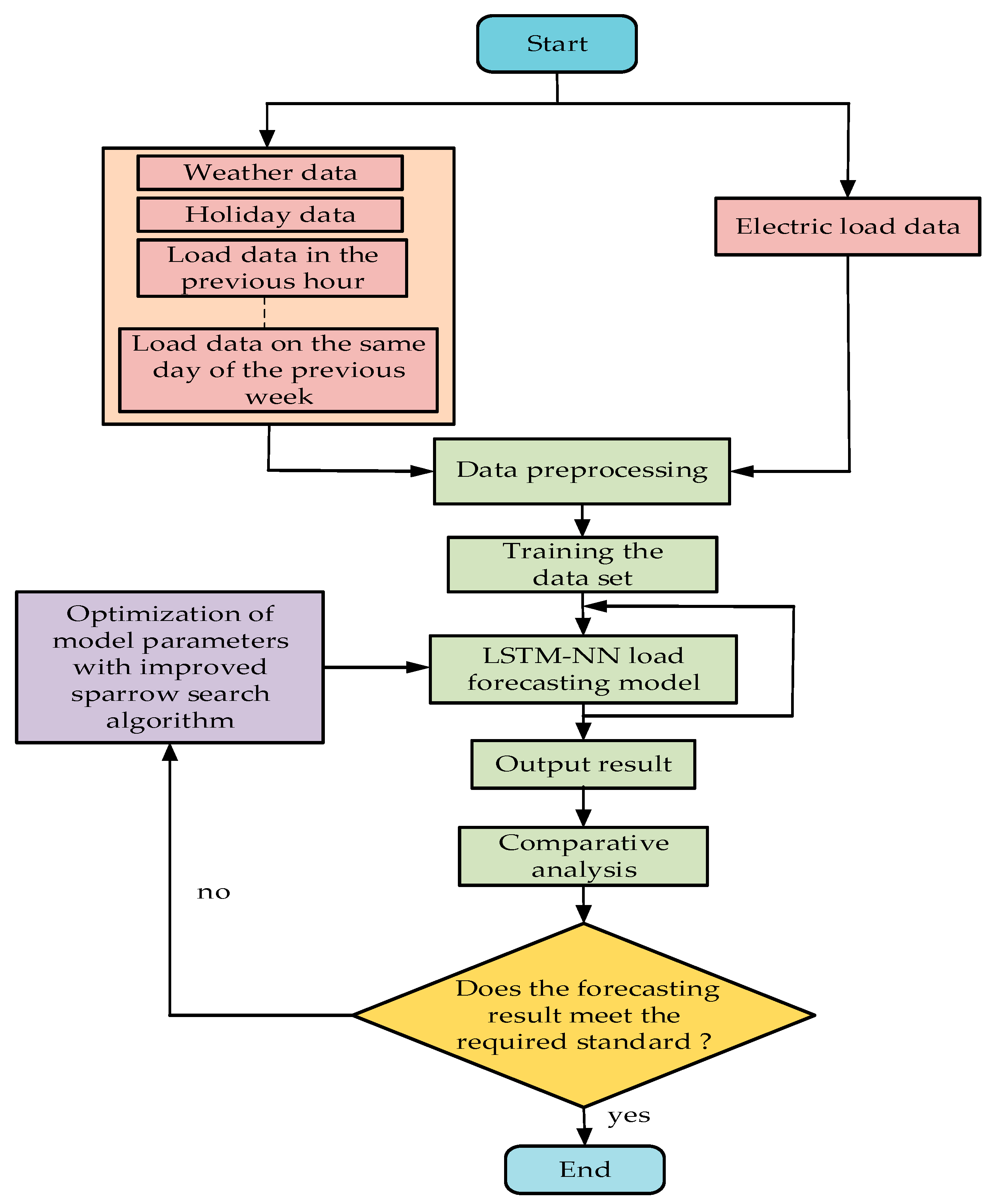
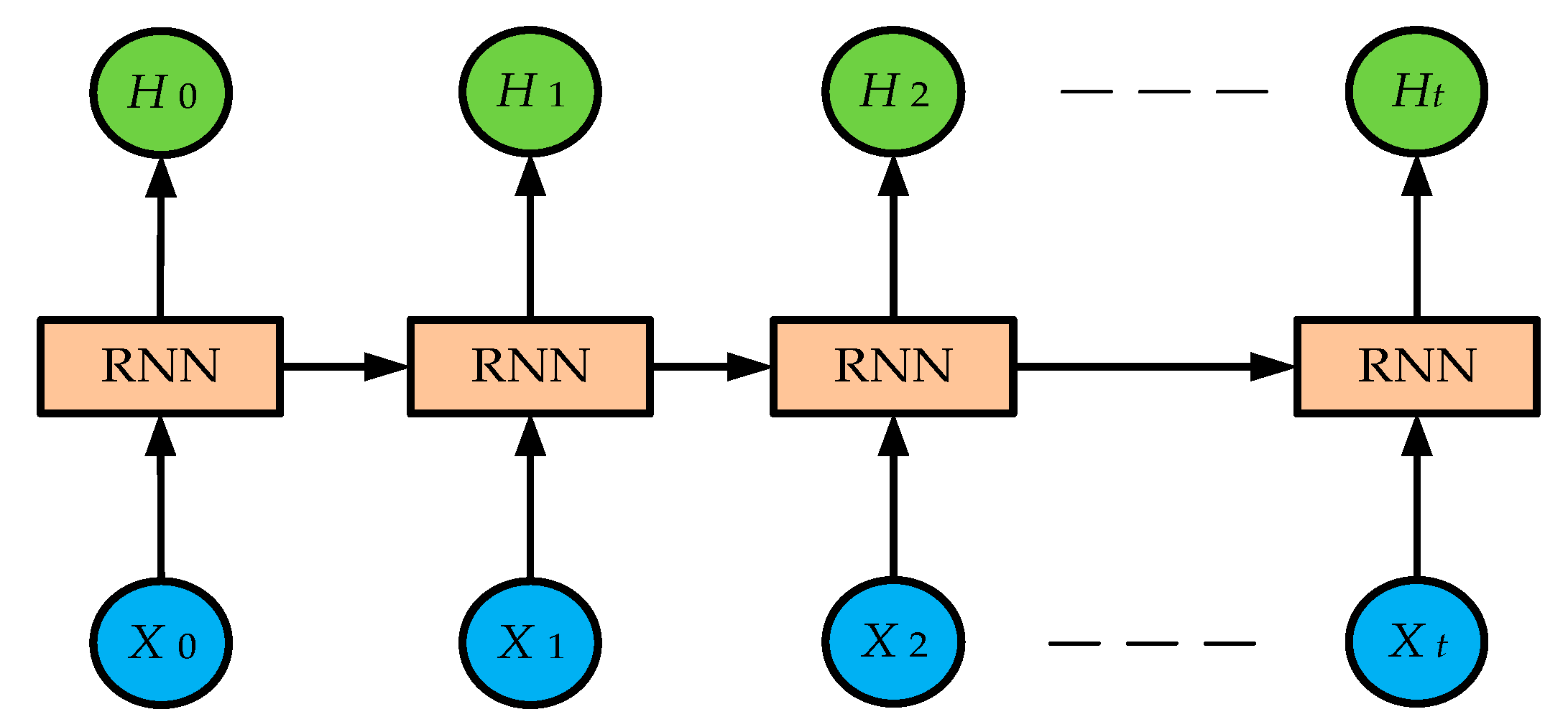
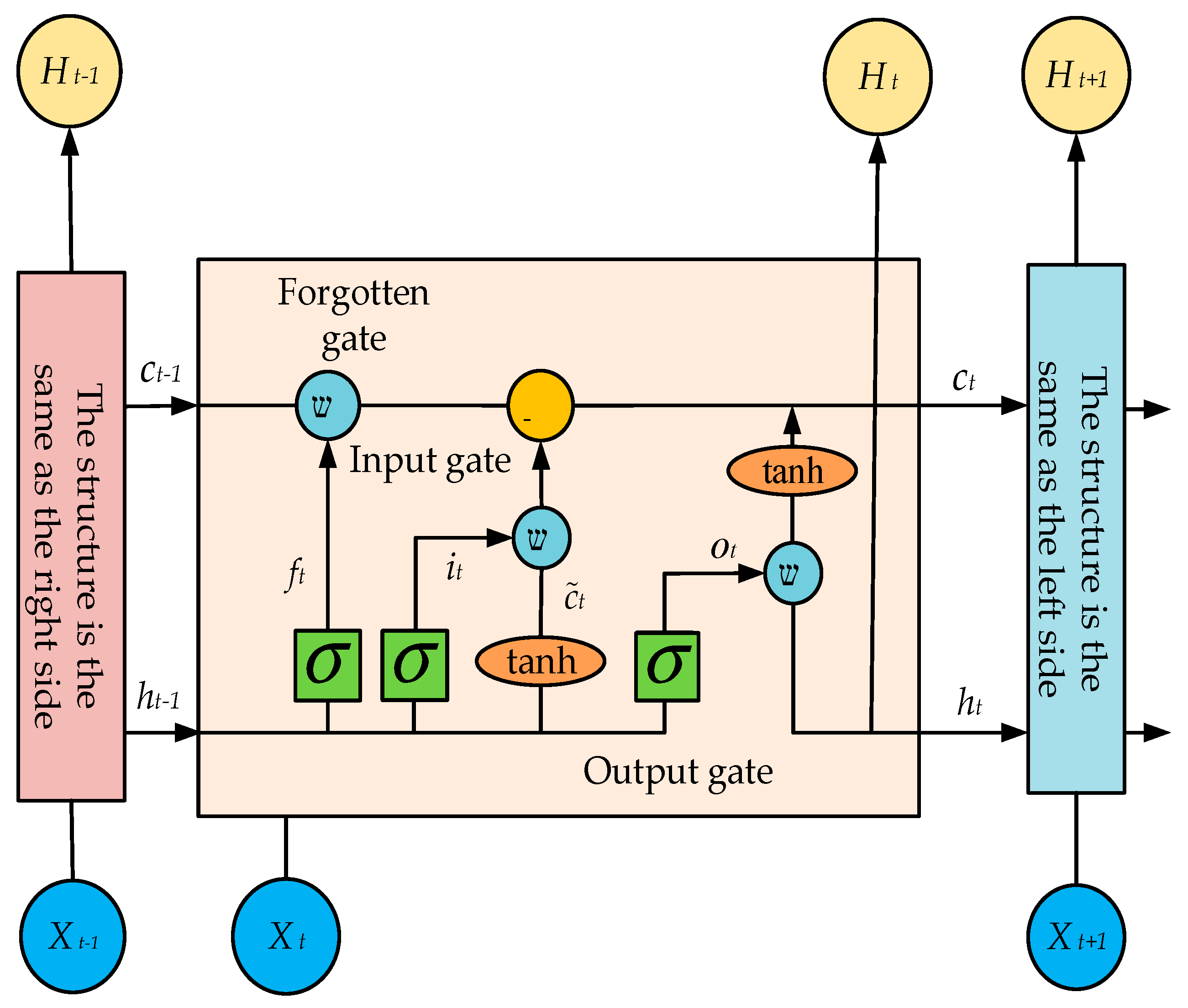
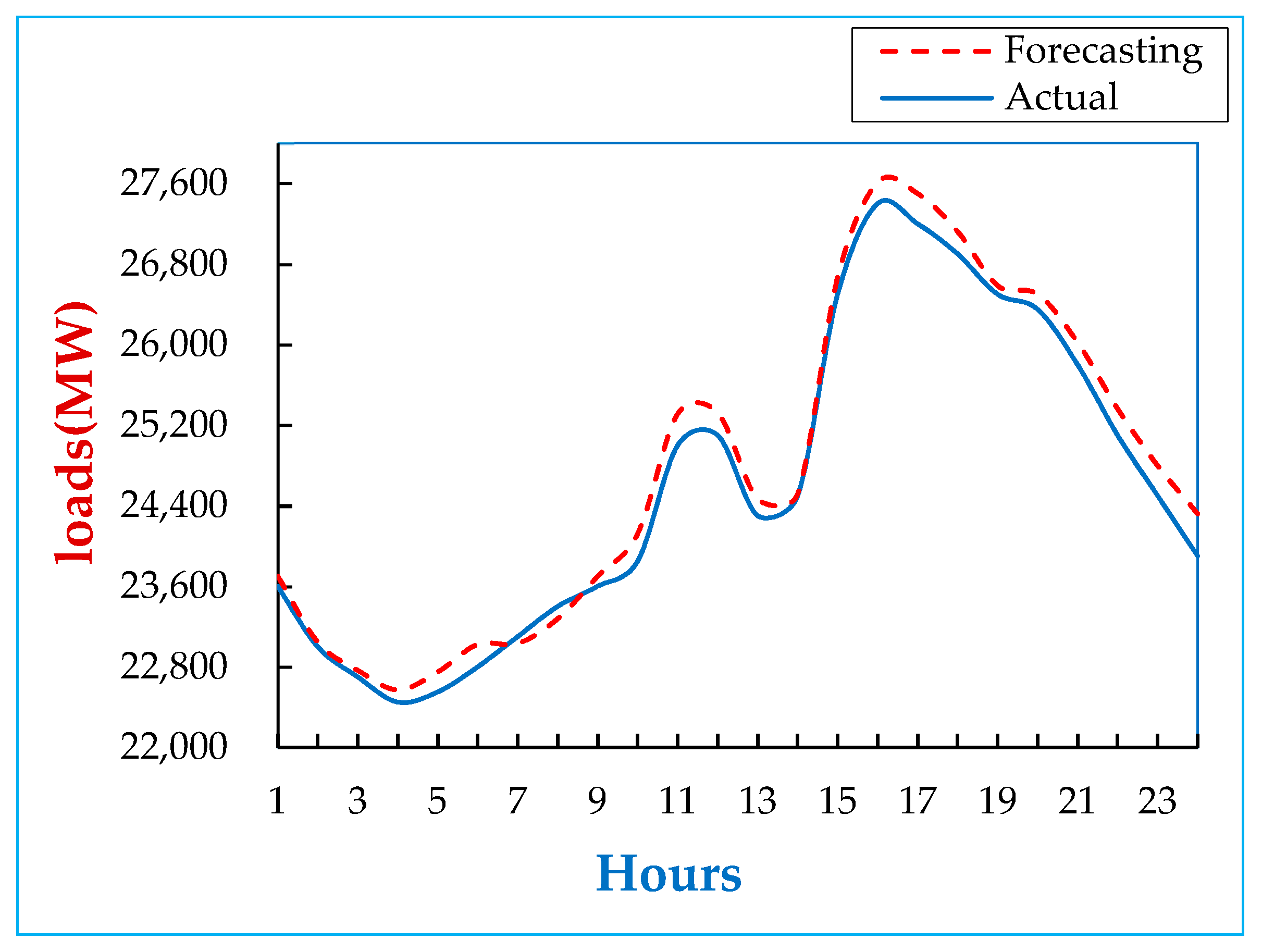

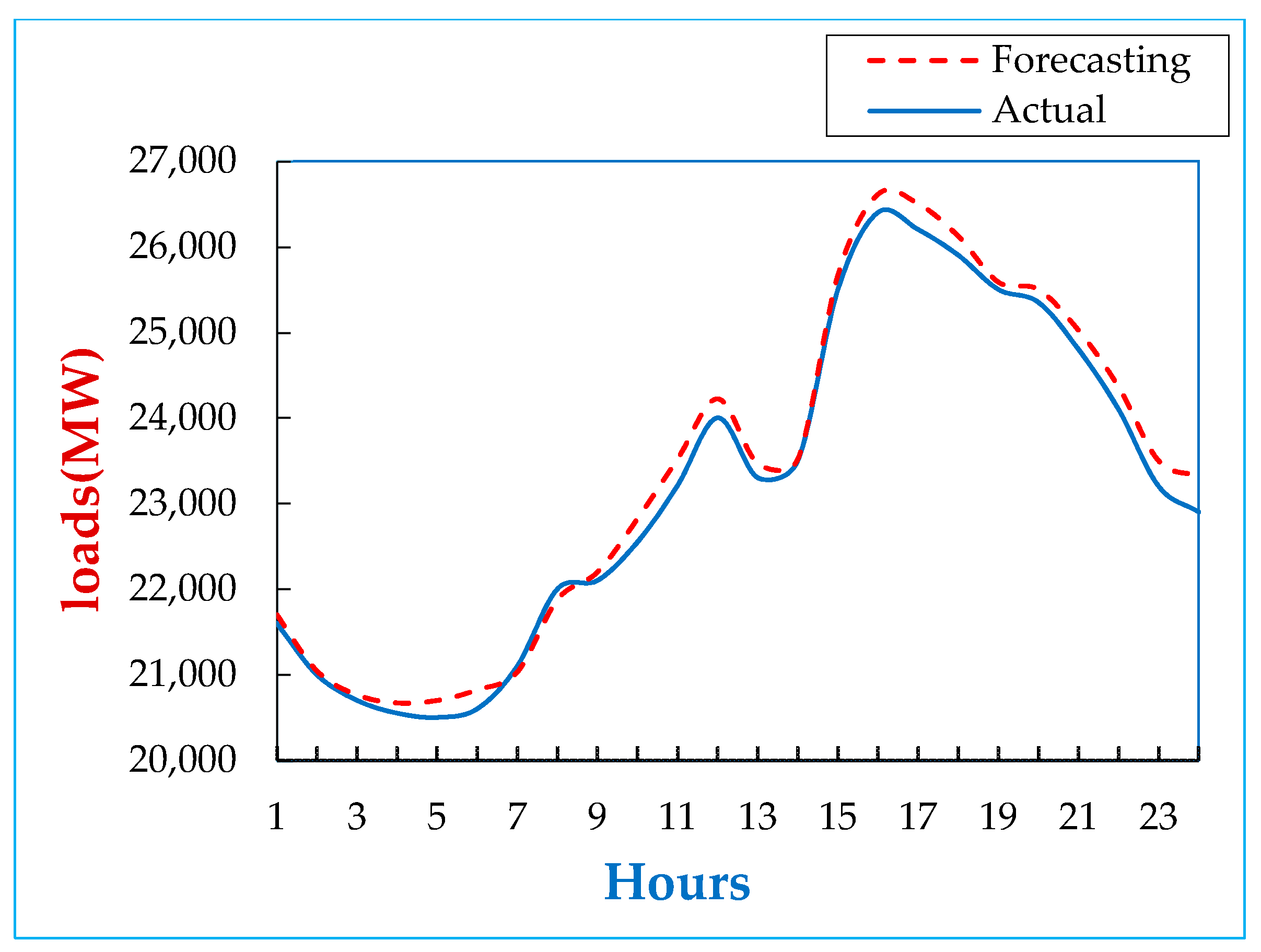
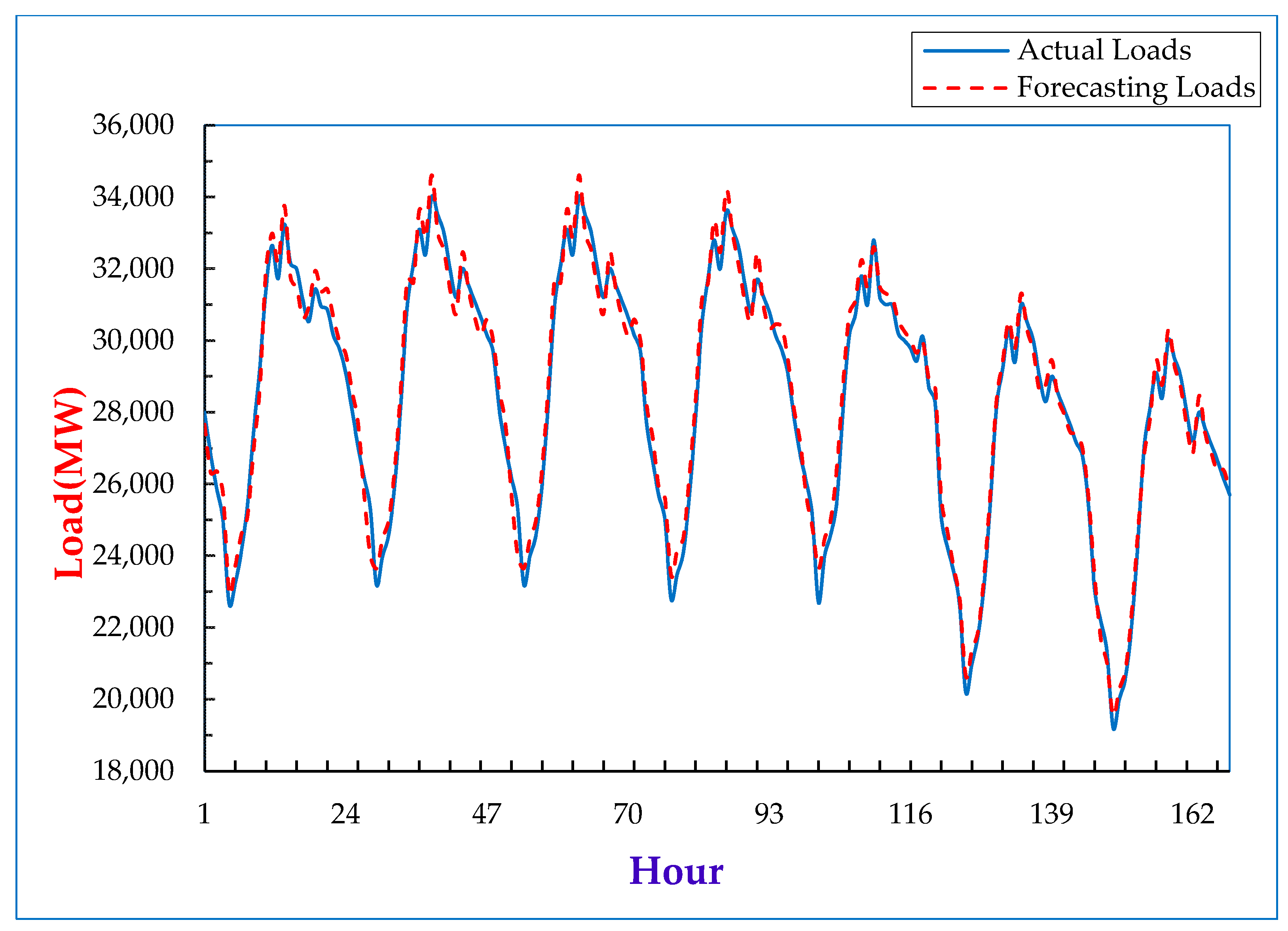
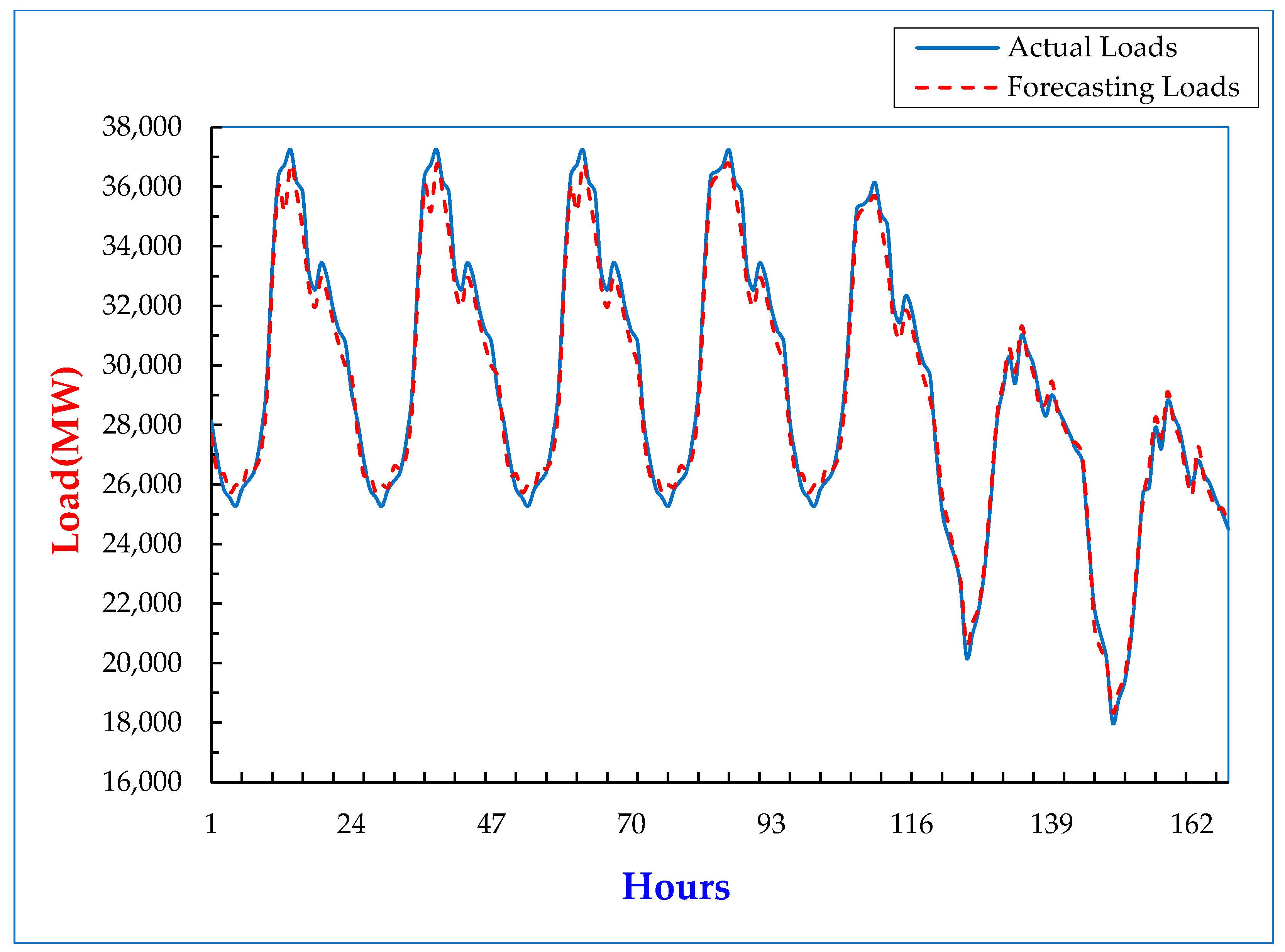
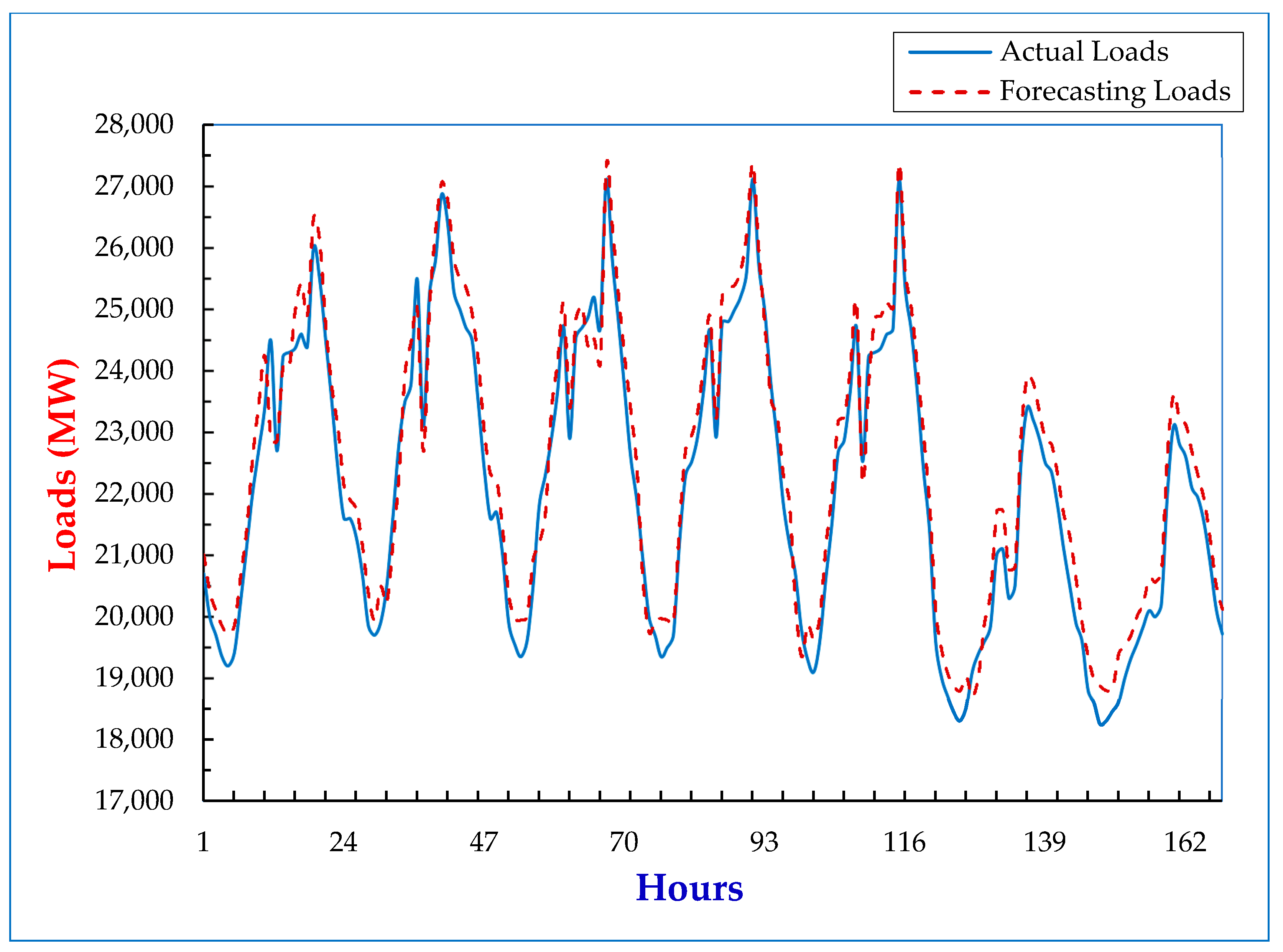
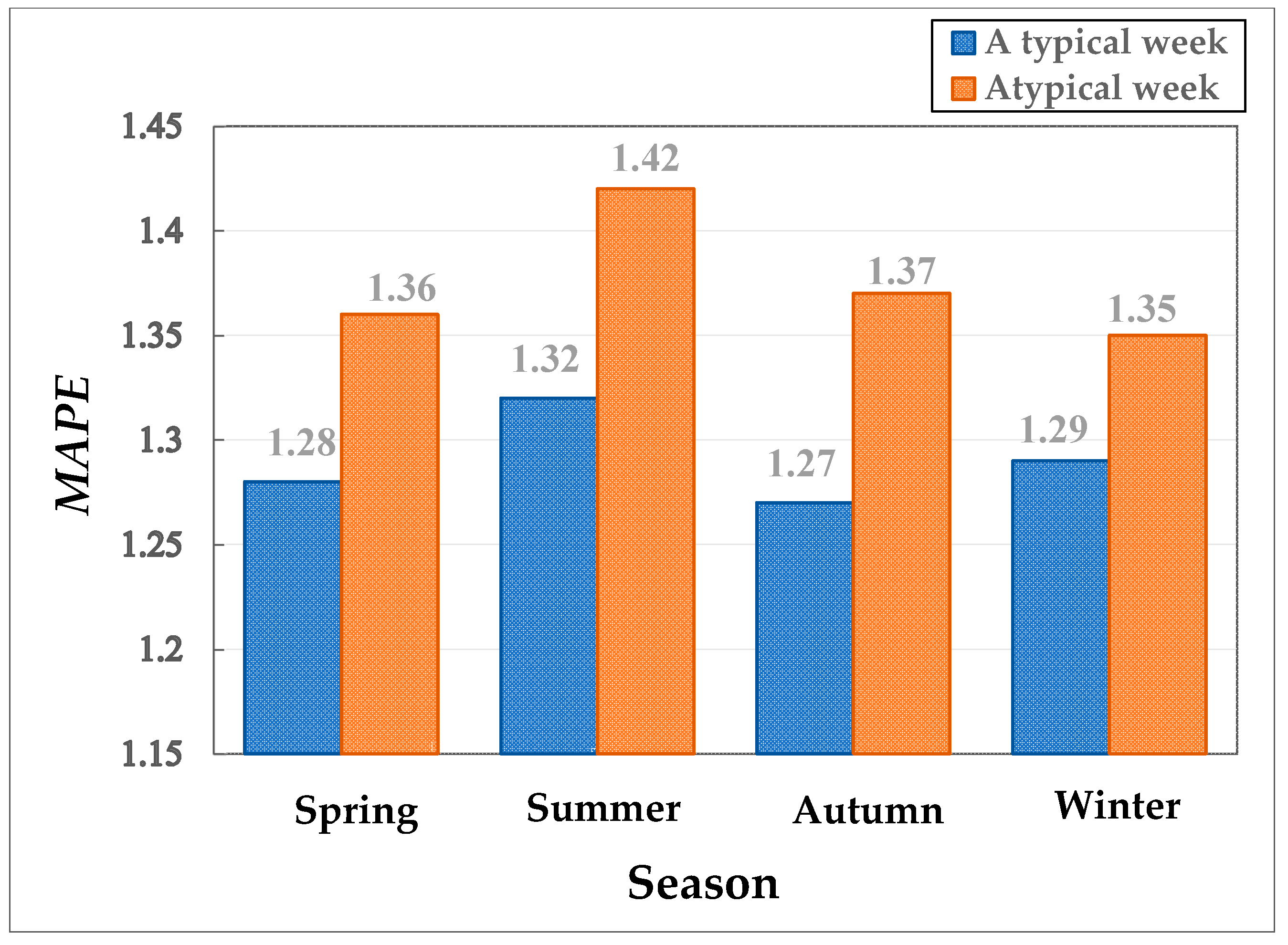
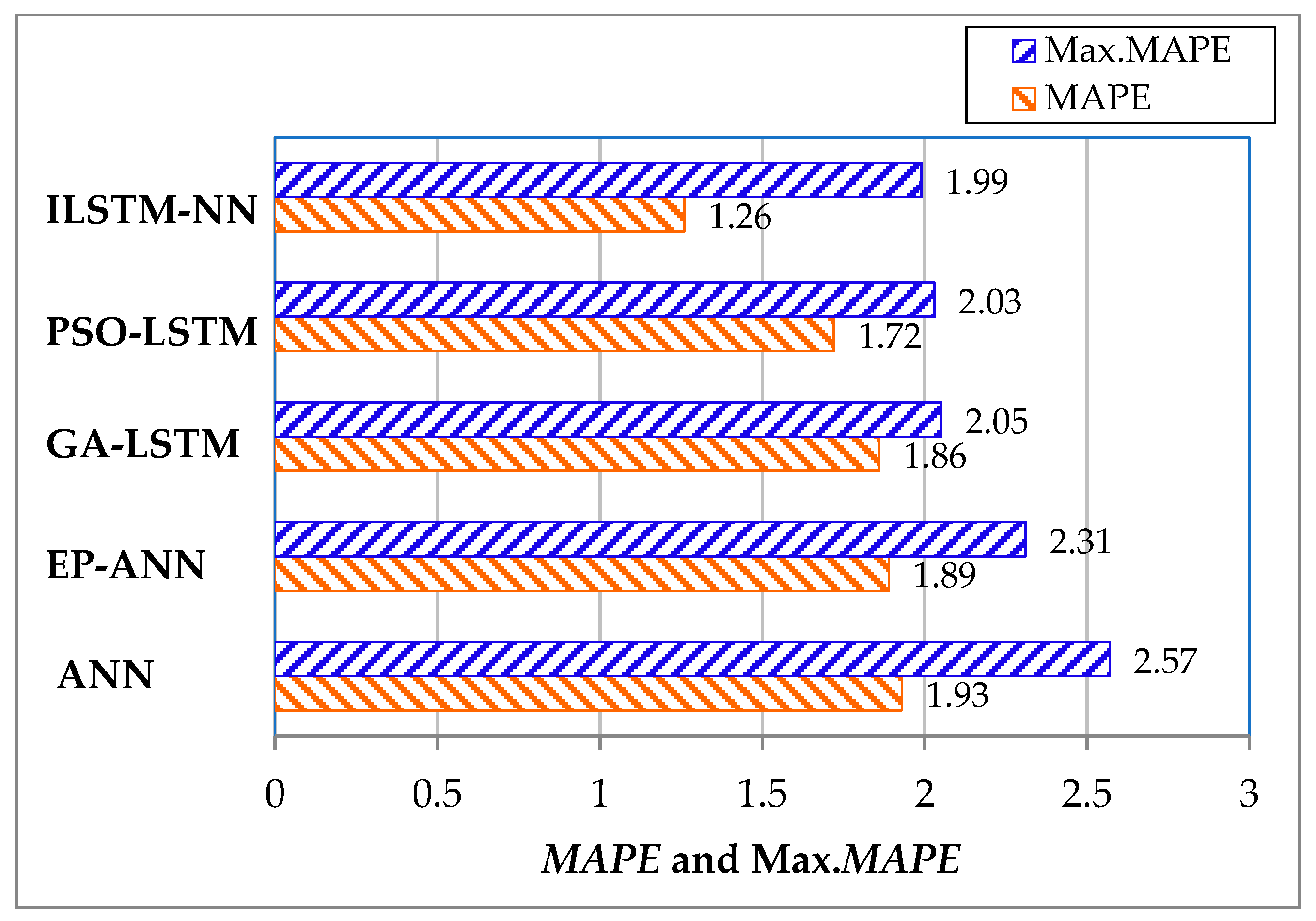
| Day Type | ANN | EP-ANN | GA-LSTM | PSO-LSTM | ILSTM-NN | ||||||||||
|---|---|---|---|---|---|---|---|---|---|---|---|---|---|---|---|
| RMSE (MW) | RMSE (MW) | RMSE (MW) | RMSE (MW) | RMSE (MW) | |||||||||||
| Working days | 1.93 | 2.57 | 447 | 1.89 | 2.31 | 438 | 1.86 | 2.05 | 431 | 1.72 | 2.03 | 399 | 1.26 | 1.99 | 292 |
| Non-working days | 1.95 | 2.68 | 452 | 1.92 | 2.35 | 445 | 1.92 | 2.18 | 445 | 1.82 | 2.12 | 422 | 1.28 | 2.01 | 297 |
| Public holidays | 1.95 | 2.75 | 452 | 1.94 | 2.41 | 450 | 1.97 | 2.23 | 456 | 1.92 | 2.15 | 445 | 1.30 | 2.02 | 301 |
| Rainy days | 2.01 | 2.77 | 466 | 1.98 | 2.51 | 459 | 1.98 | 2.27 | 459 | 1.97 | 2.18 | 456 | 1.32 | 2.02 | 306 |
| Average | 1.96 | 2.71 | 455 | 1.93 | 2.40 | 447 | 1.93 | 2.18 | 447 | 1.86 | 2.12 | 431 | 1.29 | 2.01 | 299 |
| Month | ANN | EP-ANN | GA-LSTM | PSO-LSTM | ILSTM-NN | |||||
|---|---|---|---|---|---|---|---|---|---|---|
| January | 2.02 | 2.92 | 1.84 | 2.11 | 1.81 | 2.09 | 1.72 | 2.08 | 1.19 | 2.02 |
| February | 1.99 | 2.87 | 1.92 | 2.25 | 1.86 | 2.57 | 1.86 | 2.12 | 1.22 | 2.06 |
| March | 2.03 | 2.52 | 1.91 | 2.18 | 1.88 | 2.12 | 1.52 | 2.02 | 1.21 | 2.03 |
| April | 1.92 | 2.76 | 1.98 | 2.32 | 1.98 | 2.35 | 1.66 | 2.13 | 1.21 | 2.01 |
| May | 1.96 | 2.72 | 1.85 | 2.41 | 1.82 | 2.13 | 1.37 | 2.22 | 1.22 | 1.97 |
| June | 2.03 | 3.12 | 2.23 | 2.87 | 2.03 | 2.78 | 2.11 | 2.31 | 1.31 | 2.15 |
| July | 2.09 | 2.89 | 2.08 | 3.23 | 2.02 | 2.31 | 1.96 | 2.35 | 1.27 | 2.23 |
| August | 2.13 | 3.23 | 2.12 | 2.78 | 2.06 | 2.22 | 2.03 | 2.23 | 1.22 | 2.32 |
| September | 2.08 | 2.51 | 2.06 | 2.36 | 1.83 | 2.05 | 1.38 | 2.07 | 1.31 | 1.99 |
| October | 1.98 | 2.37 | 1.94 | 2.58 | 1.92 | 2.01 | 1.58 | 2.11 | 1.21 | 2.02 |
| November | 1.92 | 2.48 | 1.89 | 2.34 | 1.82 | 2.52 | 1.28 | 2.15 | 1.25 | 2.01 |
| December | 1.97 | 2.52 | 1.96 | 2.72 | 1.93 | 2.65 | 2.08 | 2.09 | 1.26 | 2.03 |
| Averages | 2.01 | 2.74 | 1.98 | 2.51 | 1.91 | 2.24 | 1.71 | 2.15 | 1.28 | 2.01 |
| Time | ANN | EP-ANN | GA-LSTM | PSO-LSTM | ILSTM-NN | |||||
|---|---|---|---|---|---|---|---|---|---|---|
| 0:00 | 1.83 | 2.47 | 1.78 | 2.16 | 1.82 | 2.16 | 1.42 | 2.01 | 1.25 | 1.92 |
| 1:00 | 1.81 | 3.08 | 1.79 | 2.21 | 1.78 | 2.38 | 1.48 | 2.02 | 1.33 | 2.01 |
| 2:00 | 1.87 | 2.42 | 1.84 | 2.38 | 1.82 | 2.02 | 1.72 | 1.93 | 1.21 | 1.96 |
| 3:00 | 1.97 | 2.52 | 1.88 | 2.52 | 1.76 | 1.97 | 1.46 | 2.05 | 1.24 | 2.07 |
| 4:00 | 1.86 | 2.71 | 1.82 | 2.43 | 1.83 | 2.08 | 1.69 | 2.03 | 1.27 | 2.01 |
| 5:00 | 1.83 | 2.47 | 1.95 | 2.16 | 1.63 | 2.11 | 1.58 | 1.93 | 1.32 | 1.96 |
| 6:00 | 1.87 | 2.19 | 1.79 | 2.37 | 1.95 | 1.89 | 1.71 | 1.96 | 1.22 | 2.12 |
| 7:00 | 1.91 | 2.48 | 1.72 | 2.18 | 1.92 | 1.92 | 1.73 | 2.12 | 1.31 | 1.92 |
| 8:00 | 1.89 | 2.52 | 1.73 | 2.26 | 2.03 | 2.08 | 1.88 | 1.97 | 1.27 | 1.96 |
| 9:00 | 1.87 | 2.27 | 1.84 | 2.38 | 2.01 | 2.06 | 1.89 | 2.12 | 1.25 | 2.08 |
| 10:00 | 2.05 | 2.68 | 1.82 | 2.14 | 1.97 | 2.53 | 1.91 | 1.96 | 1.18 | 2.01 |
| 11:00 | 2.08 | 2.22 | 2.02 | 2.52 | 2.01 | 2.05 | 1.98 | 2.08 | 1.23 | 2.13 |
| 12:00 | 2.11 | 2.57 | 2.05 | 2.36 | 1.93 | 2.32 | 2.01 | 1.99 | 1.31 | 1.92 |
| 13:00 | 2.07 | 2.64 | 1.98 | 2.25 | 1.88 | 2.06 | 2.03 | 2.05 | 1.29 | 2.01 |
| 14:00 | 2.05 | 2.45 | 2.12 | 2.63 | 2.02 | 2.05 | 1.82 | 2.18 | 1.24 | 2.08 |
| 15:00 | 1.96 | 2.72 | 1.93 | 2.18 | 1.97 | 2.02 | 1.72 | 1.97 | 1.23 | 1.96 |
| 16:00 | 1.92 | 2.63 | 1.86 | 2.47 | 2.01 | 2.01 | 1.75 | 2.09 | 1.31 | 2.03 |
| 17:00 | 2.01 | 2.87 | 1.92 | 2.38 | 1.85 | 2.09 | 1.71 | 2.11 | 1.29 | 2.08 |
| 18:00 | 1.97 | 3.12 | 1.94 | 2.22 | 1.72 | 2.13 | 1.56 | 2.06 | 1.27 | 2.01 |
| 19:00 | 1.99 | 2.62 | 2.07 | 2.41 | 1.88 | 1.88 | 1.68 | 2.02 | 1.29 | 1.95 |
| 20:00 | 1.91 | 2.56 | 2.01 | 2.13 | 1.62 | 2.08 | 1.67 | 2.05 | 1.25 | 1.93 |
| 21:00 | 1.83 | 2.51 | 1.75 | 2.36 | 1.68 | 2.45 | 1.72 | 2.03 | 1.23 | 2.01 |
| 22:00 | 1.94 | 2.84 | 1.82 | 2.18 | 1.73 | 2.03 | 1.76 | 1.92 | 1.26 | 1.92 |
| 23:00 | 1.93 | 2.62 | 1.81 | 2.26 | 1.65 | 1.75 | 1.55 | 1.98 | 1.28 | 1.89 |
| Averages | 1.93 | 2.57 | 1.89 | 2.31 | 1.86 | 2.05 | 1.72 | 2.03 | 1.26 | 1.99 |
Publisher’s Note: MDPI stays neutral with regard to jurisdictional claims in published maps and institutional affiliations. |
© 2021 by the author. Licensee MDPI, Basel, Switzerland. This article is an open access article distributed under the terms and conditions of the Creative Commons Attribution (CC BY) license (https://creativecommons.org/licenses/by/4.0/).
Share and Cite
Liao, G.-C. Fusion of Improved Sparrow Search Algorithm and Long Short-Term Memory Neural Network Application in Load Forecasting. Energies 2022, 15, 130. https://doi.org/10.3390/en15010130
Liao G-C. Fusion of Improved Sparrow Search Algorithm and Long Short-Term Memory Neural Network Application in Load Forecasting. Energies. 2022; 15(1):130. https://doi.org/10.3390/en15010130
Chicago/Turabian StyleLiao, Gwo-Ching. 2022. "Fusion of Improved Sparrow Search Algorithm and Long Short-Term Memory Neural Network Application in Load Forecasting" Energies 15, no. 1: 130. https://doi.org/10.3390/en15010130
APA StyleLiao, G.-C. (2022). Fusion of Improved Sparrow Search Algorithm and Long Short-Term Memory Neural Network Application in Load Forecasting. Energies, 15(1), 130. https://doi.org/10.3390/en15010130





